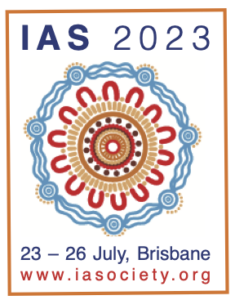ART-associated hypertension can be successfully treated in African settings
1 August 2023. Related: Conference reports, Side effects, Coinfections and complications, IAS 2023 Brisbane.
Polly Clayden, HIV i-Base
 Hypertension, after starting HIV treatment, was common in an analysis of two African trials comparing first-line ART regimens – according to data presented at IAS 2023. [1]
Hypertension, after starting HIV treatment, was common in an analysis of two African trials comparing first-line ART regimens – according to data presented at IAS 2023. [1]
In NAMSAL, in which hypertension was not routinely treated, this was more frequent among people receiving dolutegravir (DTG)-based than efavirenz (EFV)-based ART (plus tenofovir disoproxil fumarate [TDF] and 3TC), at 192 weeks.
In ADVANCE, where most cases of hypertension were successfully treated, there was no difference between DTG and EFV arms, including in ART that included DTG and tenofovir alafenamide (TAF), at 192 weeks.
Presenting author Francois Venter made the case for diagnosing and treating hypertension, which can be done successfully with inexpensive generic drugs.
Hypertension is a leading cause of death in sub-Saharan Africa, with a high background prevalence in the general population. TAF and DTG have been associated with higher risks of obesity than tenofovir disoproxil fumarate (TDF) or efavirenz (EFV). Clinical obesity increases the risks of hypertension and other non-communicable diseases.
The study was a secondary analysis of NAMSAL and ADVANCE, looking at ART and hypertension and whether this was associated with particular antiretrovirals.
NAMSAL
In the NAMSAL trial, 613 participants in Cameroon were randomised to TDF/3TC/DTG or TDF/3TC/EFV (EFV 400 mg). Blood pressure was measured at every study visit.
In Cameroon, like many African countries, free routine hypertension treatment is not offered in primary healthcare. About 1% of participants in NAMSAL had hypertension at entry and very few were treated over the course of the study.
Median BMI was 23 kg/m2 in this study and CD4 was about 280 cells/mm3.
As the participants’ BMI increased, so did the prevalence of hypertension. Over a third (37%, 17/46) of participants with BMI over 30 developed grade 1 hypertension compared to less than 10% of those with normal BMI.
NAMSAL previously demonstrated a rise in weight over 192 weeks, which was more significant on the DTG arm and among women.
Blood pressure increased in both study arms. Between week 60 and 72 mean SBP became significantly greater in the DTG arm, p=0.02. By week 192 this difference was 6.5 mm/Hg, p<0.01.
At baseline 12% and 10% of participants in the DTG and EFV arms had high blood pressure (SBP>140 or DBP>90). This difference became significant at by week 144, when these proportions were 25% and 12%, p=0.001. At week 192, 31% of participants had developed hypertension in the DTG arm, vs 19% in the EFV arm, p=0.002. There were also corresponding significant differences across DAIDS hypertension grades 1 to 3.
Very few participants in NAMSAL had their blood pressure treated over this course of events.
ADVANCE
In the ADVANCE trial, 1053 participants in South Africa were randomised to TAF/FTC/DTG, TDF/FTC/DTG or TDF/FTC/EFV (standard dose EFV, 600 mg).
In South Africa, people are routinely treated for hypertension.
BMI at baseline was slightly higher in ADVANCE than NAMSAL, median 24 kg/m2, as was CD4 count at about 340 cells/mm3.
Weight also increased over time in this study and this was more pronounced among black women and in the TAF arm and both DTG arms. Francois Venter noted that this is likely to be due to EFV and TDF mitigation of weight gain.
About 10% of participants entered the study already being treated for hypertension. This increased by about 11% during the study and almost all (95%) the participants with hypertension were treated.
The risk of treatment-emergent grade 1 hypertension was significantly higher in the TAF/FTC/DTG arm vs TDF/FTC/EFV, p=0.038.
By 192 weeks there was just over 2 mm/Hg difference between the TAF and DTG arm and the EFV arm.
The difference in blood pressure between the merged DTG arms and the EFV arm only became significant at week 192: respectively 54% vs 45%, p=0.047.
There was almost no difference between the combined DTG arms and the EFV arms in DAIDS graded hypertension at week 192, except for 43% vs 35% with high normal blood pressure, p=0.047.
comment
The authors pointed out that an important limitation to this analysis is that blood pressure measurement is not standardised – and not just across HIV studies. One of the confounders was standardised cuff size (bigger sizes are recommended for people with BMI of 35 and above).
The analysis is ongoing and the group are looking at weight and renal markers. Of note, when people on hypertensive drugs in ADVANCE were removed from the analysis, initial data suggests that blood pressure is mediated by weight gain not drug choice.
They also noted that higher risks of hypertension are at least partly due to rising body weight on ART and ageing. And they asked the question if this is a “return to health” effect?
When the authors looked at the risk of hypertension in over 20 randomised first- and second-line studies the results were inconsistent. And some studies did not measure blood pressure at all. But seven observational studies in various populations and settings showed higher risk of hypertension with DTG vs EFV.
The authors cautioned that mistakes were made with attribution to specific antiretrovirals with weight gain and the need to take care with these analyses.
The key message that hypertension “can be very successfully treated, if you diagnose it” deserves repeating here.
Reference
Venter F et al. Risks of hypertension with first-line dolutegravir (DTG) and tenofovir alafenamide (TAF) in the NAMSAL and ADVANCE trials. IAS 2023. Brisbane. Australia. 23–26 July 2023. Oral abstract 5640.
https://ias.reg.key4events.com/key4register/AbstractList.aspx?e=96&preview=1&aig=-1&ai=52401 (abstract)
https://conference.ias2023.org/media-1110-track-b-late-breaker (webcast)

